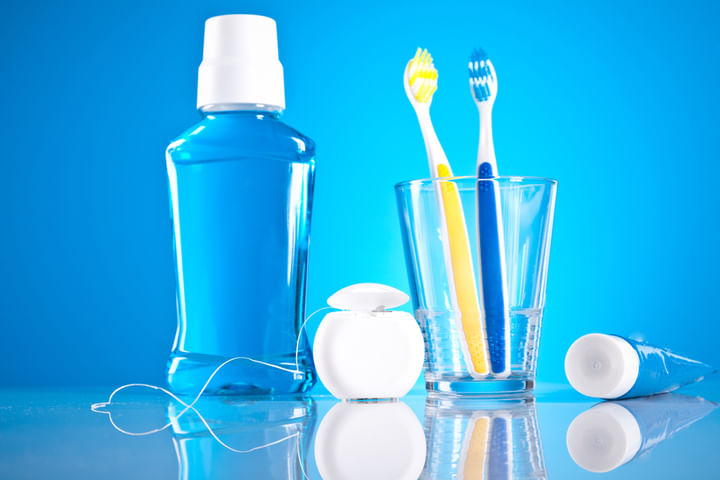Brushing, Flossing and Mouthwash Tips
Brushing:
Brushing seems like such an easy thing to do right? Then why do so many people do it so infrequently or ineffectively? I’ve had teenager (and occasionally adults) who even admit that they haven’t brushed their teeth in a week! Please don’t be this person! I’m going to go through some easy tips to make brushing more effective and help you reduce your risk of cavities, gum disease, and bad breath. Improving your oral hygiene is easy and doesn’t take much time at all! The biggest thing you’ve got to do is make a habit of it. A habit takes about 21 days of practice before it is ingrained. After it is a habit, it won’t feel difficult or like it is a chore and it’ll make a huge difference in your oral health.
Tip #1: Brush twice a day for 2 minutes each time with a fluoride toothpaste. Most people like to do this first thing in morning to get rid of morning breath and then right before bed. If you only can pick one, brush before bed. Your saliva production decreases at night and if you’ve got sugar or acid on your teeth, they’re more susceptible to attack. Two minutes is also important. You want enough time to fully remove all the build-up on your teeth (which take longer than you think) and allow the fluoride to be taken up into your tooth. The fluoride can’t be taken up effectively until you’ve cleaned all that mess off your teeth. If you want to be really thorough buy some plaque disclosing solution and use it before you brush your teeth. This will stain all the plaque on your teeth and will let you know when you’ve gotten it all off.
Tip #2: Don’t hold your toothbrush with the bristles at a 90 degree angle to your teeth. You want to hold it at a 45 degree angle to your teeth with the bristles pointing towards your gums and do quick vibrating or circular motion all around your mouth. This helps clean the plaque away from the area by the gums which is generally the hardest spot to keep clean. Another good way to brush is to place your tongue at a 45 degree angle to your gums and sweep the toothbrush down along the side of the tooth. The fancy name for this is the “modified bass method”. It works great if you spend a lot of time doing it but most people can’t pull this off consistently.
Tip #3: Don’t rinse your mouth out with water or mouthwash after brushing. Just spit out the toothpaste. This allows the ingredients in the toothpaste to continue working.
Tip #4: Always brush your tongue or use a tongue scraper. Your tongue is covered in taste buds that give food and bacteria a great place to hide. If you notice your tongue is a different color (like white, brown, or black) you’ve got a lot of work to do! Your tongue should be a nice pink color with no coating on the top of it. A lot of people have bad breath because they don’t do this.
Tip #5: Don’t brush right after drinking something acidic like soda or orange juice. The acid temporarily makes your enamel softer and you can actually brush some of it off if you brush immediately. Instead wait a minimum of 30 minutes and I’d probably recommend waiting even longer than that if you’re able to.
Tip #6: Consider investing in an electric toothbrush. They do a phenomenal job getting your teeth clean in a much shorter period of time than a manual toothbrush. The best types of electric toothbrushes are the ones with round heads that rotate and oscillate around. All you have to do is place it on the different surfaces of your teeth for a short period of time and it does all the work for you. No brushing or special technique needed. If you have poor dexterity in your hands (such as in children or the elderly) this becomes even more important. I think every kid should have a cheap electric toothbrush (cheap because they inevitably end up thrown off the counter, or in the toilet!). I’ve seen them for as little as $5 at places like Walmart.
Flossing:
For some reason everyone hates doing this even though it is so fast and easy. I have so many patients who will go to the gym every single day for an hour but can’t spare the extra half a minute to floss their teeth. I can guarantee you that flossing for 30 seconds a day has a much bigger overall health impact than 30 seconds at the gym. I can personally floss my teeth in 10-20 seconds. You can too with a little practice. Here are some tips on how to floss effectively and motivate you to keep doing it.
Tip #1: Make it a habit! Just like with brushing you need some time to make this a habit. Again, force yourself to do it at the same time each day for 21 days straight. After that it gets easy. Do it every night before going to bed. You’ll thank yourself when it is time to go to the dentist and when your teeth aren’t falling out at age 50 or 60.
Tip #2: Use a floss that is easy to use for you. Those flosses that shred and are a pain are why people hate flossing. The best floss is the one that you will use! My patients ask me all the time what I recommend. I always tell them that I don’t care what they use as long as they are using something!
Tip #3: “Only floss the teeth you want to keep”. Periodontal disease (bone loss around your teeth) is the number one reason why people lose teeth. I’ve never seen someone who flosses regularly develop periodontal disease (unless there was some rare underlying medical condition).
Tip #4: If you are terrible at flossing or can’t get into it, try purchasing a Waterpik and use that instead. A waterpik has a small wand with a tip that shoots a stream of water that can be used to clean between your teeth. It is just as effective as floss and can making cleaning around bridges or braces much easier than traditional floss. Want really good breath afterwards? Fill it up with mouthwash instead of water and you’ll kill two birds with one stone.
Tip #5: If you’ve got big spaces between your teeth, try using soft piks instead of floss. There are a lot of variations and sizes with these but they all look basically the same. They look similar to little tiny christmas trees or pipe cleaners. You can find these next to the floss in most stores or you can usually find them in bulk online for better prices. They are small enough to fit in between the small spaces between your teeth but large enough that they clean the spaces really well! I’ve got a lot of older patients who do great keeping their teeth clean and use these exclusively.
Mouthwash:
Tip #1: Mouthwash cannot replacing brushing or flossing, ever! Listerine made this claim a while back, got sued for making false claims, and it was upheld in court! Always make brushing and flossing a priority before using mouthwash. It does work well in addition to doing these things.
Tip #2: Don’t use mouthwash immediately after brushing. This removes the ingredients from the toothpaste that are helping to protect your teeth. Wait at least 30 minutes. For most people they should brush their teeth in the morning, use mouthwash after lunch, and then brush and floss right before bed.
Tip #3: Figure out what mouthwash is correct for your situation. You can find mouthwashes that are better for breath control, dry mouth, reducing cavities, or a combination of all of them.



+1.svg)
